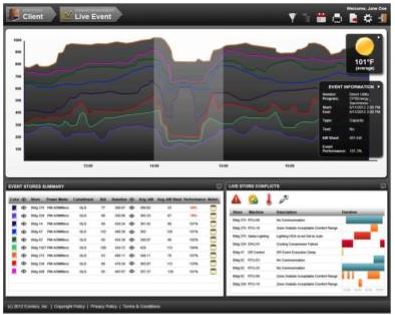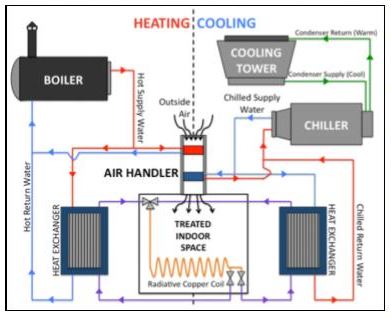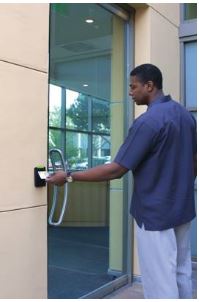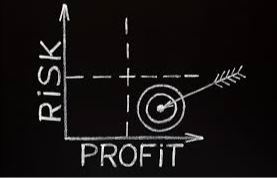|
January 2014
Article
AutomatedBuildings.com
|
[an error occurred while processing this directive]
(Click
Message to Learn More)
|
|
Defining a Smart Building: Part Five
We complete the
definition of a smart building by addressing HVAC, communication and
data infrastructure, access control systems, advanced building
management systems and sustainability.
|

Jim
Sinopoli PE, LEED BD+C, RCCD
Managing
Principal,
Smart
Buildings LLC
Contributing Editor
|
Numerous research
companies and organizations are predicting
significant growth in the smart building market. One company, Markets
and Markets, expects the global marketplace to grow at a stunning
compounded annual rate of 35% over the next five years. While it’s
difficult to compare market research because there are various
definitions of what sub-markets (smart homes, smart grid, etc.) make up
the larger smart building market, most research of the smart building
area indicates substantial growth worldwide. Given the general economic
outlook for the global economy is relatively flat or for modest growth
it’s impressive that smart buildings are such a rapidly growing
segment, but this is by no means a surprise.
There are several factors creating demand for smart buildings. One of
the most potent are the results from building owners that have already
deployed smart building technology. These building owners have found
reductions in energy consumption, enhancements to operations and a very
attractive return on investment. Such examples and stories validate the
approach, verify the likely results and reduce the risk for other
building owners to plan to deploy the technologies. Another element
driving the market for smart buildings is our global society’s
habituation to real-time information and communications technology;
people not only accept cutting-edge technology as an integral part of
our buildings but expect that their buildings will be smart.
An additional factor is that while the marketplace is expansive and
rapidly evolving, there are elements that comprise a smart building.
These include system integration, advanced building management tools,
extensive automation and sensors, energy management, enterprise data
management, data analytics, software applications and the leveraging
and incorporation of IT. It is this type of emerging clarity that can
guide designers, contractors and manufacturers, as we complete the
definition of a smart building by addressing HVAC, communication and
data infrastructure, access control systems, advanced building
management systems and sustainability.
Advanced Building Management System.
 The driver in advanced building
management systems is the increasing
complexity of buildings. From an equipment or hardware perspective we
now have buildings with energy and sustainability systems which are
relatively new for buildings, systems that even five years ago were not
commonplace. These include systems such as rain water harvesting,
exterior shading, water reclamation, renewable energy, electric
switchable glass, sun tracking systems, etc. Maintaining and optimizing
each of these new systems is a challenge, further burdening and
increasing challenging for facility management. The other aspect of
increased complexity is related to management decisions regarding
building operations. Many of these decisions now involve several
variables, with some situations requiring real time decisions, for
example a demand response event from a utility requiring immediate
action.
The driver in advanced building
management systems is the increasing
complexity of buildings. From an equipment or hardware perspective we
now have buildings with energy and sustainability systems which are
relatively new for buildings, systems that even five years ago were not
commonplace. These include systems such as rain water harvesting,
exterior shading, water reclamation, renewable energy, electric
switchable glass, sun tracking systems, etc. Maintaining and optimizing
each of these new systems is a challenge, further burdening and
increasing challenging for facility management. The other aspect of
increased complexity is related to management decisions regarding
building operations. Many of these decisions now involve several
variables, with some situations requiring real time decisions, for
example a demand response event from a utility requiring immediate
action.
The shortcomings of the typical legacy BMS is quite a long list,
including limited integration capabilities, inadequate and elementary
analytic tools, proprietary programming languages, a dearth of software
applications and legacy user interfaces.
A smart building will have an advanced building management system with
an open programming language where all integration is accomplished via
software. It requires middleware to normalize and standardize all data
from sub-systems into an open, standardized database using SOAP/XML or
other computer software exchange architecture. The database would
include all physical, virtual and calculated points. The user interface to the advanced systems are displays and dashboards
completely configurable and customizable by users, with access via a
browser. The system would be capable of data exchange with information
in enterprise and business level software, providing a suite of
software applications such as energy management, building performance
analytics, alarm management, and automatic fault detection and
diagnosis.
Communication and Data
Infrastructure
[an error occurred while processing this directive]
The method of communication and data exchange within and between
building systems is vital. It is a foundation that will determine the
difficulty or ease of integrating system functionality and data. Smart
buildings shun proprietary protocols in favor of standard open
communications protocols based on the ASHRAE BACnet I/P, OPC DA, Modbus
TCP, oBIX, XML, SOAP and SNMP standards of data exchange or similar
open standard protocols. Many building products now incorporate open
protocols, some going through a process that verifies or certifies
their adherence to the protocol standard.
The network architecture of building systems should take into account
the minimum speeds for serial buses, maximum size in points and devices
per serial bus, maximum number of serial buses per network controller,
and the use of native open protocol controllers versus gateways in
existing buildings.
The adherence to standard open protocols and detailed network design
extends to not only building control systems but also to facility
management systems, business systems and IT systems in the use of
standard database structures such as SQL or ODBC, Oracle or DB2.
HVAC
In many ways, HVAC equipment is the most complicated building system,
with numerous components arranged to produce heating, cooling and
ventilation through the principals of thermodynamics, fluid mechanics
and heat transfer.
 The HVAC system not only makes the building comfortable
and healthy for
its occupants, it manages a substantial portion of the energy consumed,
as well as plays a critical role in life safety. In maintaining the
building’s air quality the HVAC system must respond to a variety of
conditions inside and outside the building (including weather, time of
day, different types of spaces within a building and building
occupancy) and do so while optimizing its operation and the related
energy usage. Given the variety of conditions and the potential
complexity of a substantial HVAC system this necessitates extensive
automation and system integration. For example, in a smart building we
expect the HVAC system to automatically sequence chillers, pumps, and
boilers, as well as automatically rotate parallel chillers, pumps, and
boilers by accumulated run-time. The HVAC system should also perform an
optimal start calculation based upon real occupancy history instead of
estimated start times.
The HVAC system not only makes the building comfortable
and healthy for
its occupants, it manages a substantial portion of the energy consumed,
as well as plays a critical role in life safety. In maintaining the
building’s air quality the HVAC system must respond to a variety of
conditions inside and outside the building (including weather, time of
day, different types of spaces within a building and building
occupancy) and do so while optimizing its operation and the related
energy usage. Given the variety of conditions and the potential
complexity of a substantial HVAC system this necessitates extensive
automation and system integration. For example, in a smart building we
expect the HVAC system to automatically sequence chillers, pumps, and
boilers, as well as automatically rotate parallel chillers, pumps, and
boilers by accumulated run-time. The HVAC system should also perform an
optimal start calculation based upon real occupancy history instead of
estimated start times.
Control of the HVAC system for occasional use facilities
such as
meeting rooms, conference rooms, cafeterias, etc. is also important in
reducing unnecessary energy consumption. HVAC for those spaces needs to
be integrated into another system which can supply data to the HVAC
system regarding use or occupancy. These include data from access
control system, video surveillance, a people counter system, lighting
control, a RTLS/RFID system or more likely, occupancy sensors.
The HVAC system also plays a substantial role in a demand response
events as well as demand limiting. Data from the utility or a power
management system communicated to a BMS and chiller controls can be
used to adjust the electric demand of the HVAC system to an acceptable
level.
Access Control System
Access control systems are a critical component in smart buildings as
security has become more important. The access control system is also
essential for life safety and is interfaced to the fire alarm system to
facilitate building egress during life safety evacuations. Access
control systems must interface or integrate with several other smart
building systems (video surveillance, HVAC, and others) as well as
share data with business systems, such as human resources, and time and
attendance.
 In a smart building, a one electronic
access control system for
non-public areas should be deployed. Within secured areas the access
control system would provide two levels of authentication. The system
should support offline operation to allow doors to function if network
connectivity is lost. The access control system should be supplemented
by an intrusion detection system at potential unauthorized entrances,
such as windows. While access cards are generally used in many systems,
biometric authentication may be utilized for an additional degree of
security.
In a smart building, a one electronic
access control system for
non-public areas should be deployed. Within secured areas the access
control system would provide two levels of authentication. The system
should support offline operation to allow doors to function if network
connectivity is lost. The access control system should be supplemented
by an intrusion detection system at potential unauthorized entrances,
such as windows. While access cards are generally used in many systems,
biometric authentication may be utilized for an additional degree of
security.
The access control system should be configured to maximize security.
For example its use vertical transport systems (elevators) can provide
selective access to floors based on occupant identity, as well as
spaces such as parking and garages.
Security levels would be determined by individual, floor, or areas, and
access privileges can be changed in response to building occupancy
states (i.e. time of day). An access control system can also generate anonymous occupancy statistics for
building spaces and zones. Such data can be used to correlate occupancy
to other building system such as energy consumption or lighting
schedule.
 Sustainability and
Innovation
Sustainability and
Innovation
Green buildings and smart buildings have different focuses but they
also overlap. A primary component of a smart building is energy
efficiency and sustainability, acknowledged by an industry
certification such as LEED, and a clear policy and plan for energy
management by the building owner. This plan may involve delegation of
responsibility for energy consumption, as well as tracking, monitoring,
and reporting systems for energy consumption. In addition building
owners would participate in demand response and automated load shedding
in cooperation with the utility company
 Innovation is integral to a smart
building. Innovation by the building
owner, designer, contractor or manufacturer that can demonstrate
benefits, value and exceptional performance should be recognized and
incorporated into the methods or criteria for deploying a smart
building.
Innovation is integral to a smart
building. Innovation by the building
owner, designer, contractor or manufacturer that can demonstrate
benefits, value and exceptional performance should be recognized and
incorporated into the methods or criteria for deploying a smart
building.
The
series of defining a smart building has touched on seventeen
attributes, with the intent of providing details and a common
perspective or framework of a smart building. Over time we would expect
additional attributes, features and continual innovation of smart
buildings. With the worldwide demand for smart buildings expanding at a
sizeable pace, the framework and definition can potentially guide the
growth and deliver results.
Defining a Smart Building: Part One
Defining a Smart Building: Part Two
Defining a Smart Building: Part Three
Defining a Smart Building: Part Four
footer
[an error occurred while processing this directive]
[Click Banner To Learn More]
[Home Page] [The
Automator] [About] [Subscribe
] [Contact
Us]
